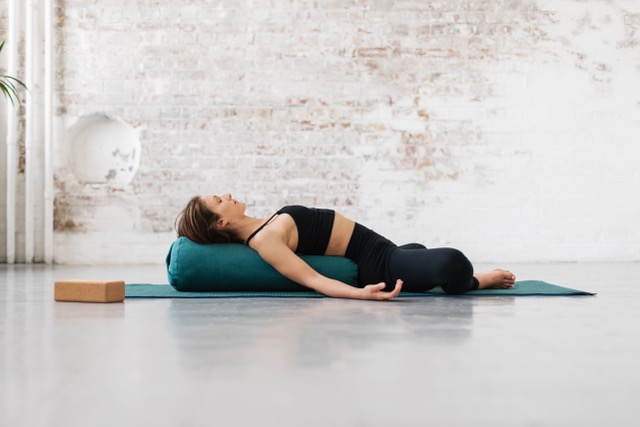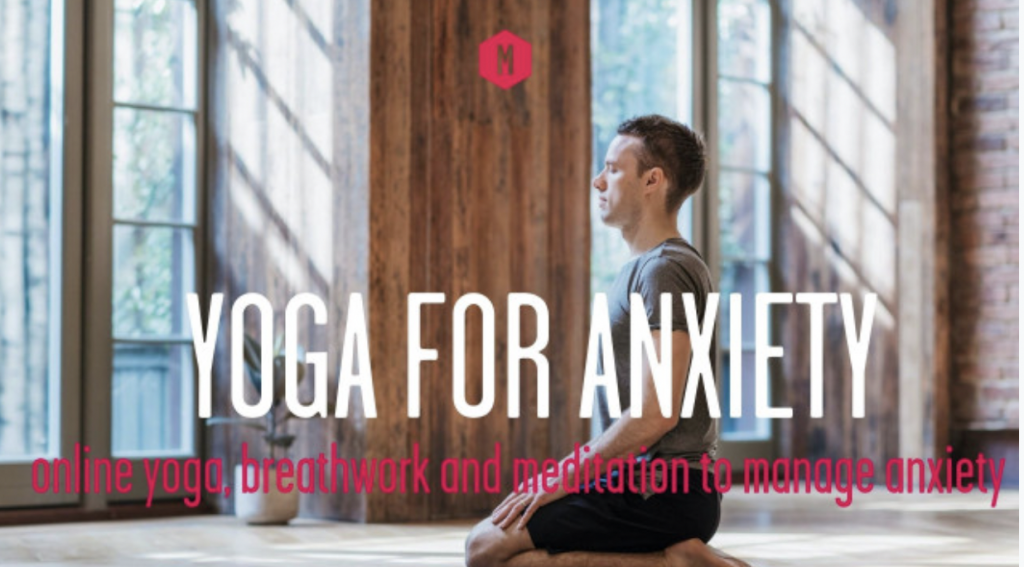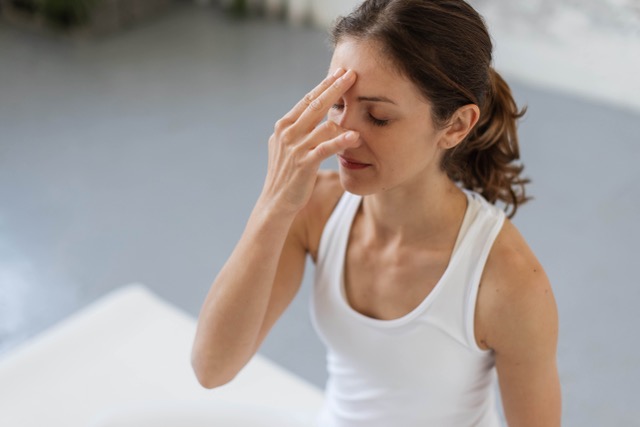
Vanessa Michielon explores the 3 ways yoga helps with anxiety. Is every Yoga style equally effective when dealing with anxiety? What are some of the most effective tools Yoga offers us to release stress and cultivate optimal wellbeing? How can we approach our practice in a way that effectively supports our Nervous system and improves
resilience?
How do you know you are anxious?
If we were to ask around, “how do you know you are anxious?”, we would probably get different
answers: I feel a knot in my throat, shaking legs, pumping heart, shallow breathing, tension in my neck and shoulders, racing thoughts, a sense of urgent fear…” In this article, I explore yoga helps anxiety
Whatever our personal experience, we can trace a recurrent pattern: a shift to a state of hyper-arousal, the “fight or flight” state, where we “time travel” reacting to a projected but not necessarily actual future threat, and initiate a protective and defensive mechanism. With its integrative approach, today Yoga is more and more recognised as a valuable complementary therapy to alleviate anxiety. As Chris Streeter explains, “many stress-related disorders are associated with an imbalance in the autonomic nervous system with too much Sympathetic (fight or flight) and to little Parasympathetic (rest, renewal and social engagement). Yoga helps to correct this imbalance.”
Read more about yoga for stress and anxiety in this complete guide
A low cost, low side effect complementary therapy
Various studies seem to support the therapeutic value of Yoga in modulating our stress response, and making us more emotionally and mentally resilient. For instance, this practice has been linked to an increased Heart Rate Variability, an indicator of the body’s ability to respond to stress in a flexible way by shifting our balance towards the Parasympathetic state.
A renowned study from 2010, (including a 12-week Iyengar Yoga intervention, has also found a higher reduction in perceived anxiety and improvement in mood in Yoga practitioners compared to subjects performing a walking exercise requiring the same energy consumption.
Another large scale study found out that Yoga and Meditation practitioners presented a smaller right amygdala (the part of the brain associated with fear and negative emotions) volume over time. This suggest that yoga “might be a feasible and accessible lifestyle intervention for people suffering from stress and stress- related diseases”
Bottom-up and top-down techniques: how yoga helps anxiety
Yoga offers us precious practical tools not only to alter our experience of reality by regulating our nervous system, but also to develop skills that allow us to stay even with our most uncomfortable sensations, including that overwhelming feeling of helplessness and dread that anxiety often brings us. The first approach – called bottom-up – involves changing the physiology of our body to change our mind, exactly like medications do. The second – top-down – changes our mind to calm our body through mindful awareness or re-patterning of our thoughts, that’s how Cognitive Behavioural Therapy works too.
Practical ways yoga helps anxiety and promotes well being and resilience
1.Pranayama: Controlling our breath to regulate our nervous system
Yoga teaches us, our breath is the primary interface between mind and body. The way we breathe changes automatically in response to stress. This also gives us the opportunity to alter our physiology through conscious changes in our breath. Anxiety is associated with shallow, chest-focused and fast breathing, while long, slow and deep breaths on the contrary are typical of the relaxation response.
By learning how to use our full lungs capacity, and cultivate coherency and fluidity in our breath,we can stimulate the Vagus nerve,the main channel of our Parasympathetic Nervous System. This communicates a sense of safety to our brain. This initiates a slowing down of our heart rate and inhibits the production of stress hormones, such as adrenaline and cortisol, reducing our perception of stress and anxiety.
Some of the most beneficial Pranayama (or Breath work) techniques we can practice are:
– a light Ujjai breath to elongate the exhalation through a slight, effortless restriction of the throat
– Dirga (3 parts breath) to use the full capacity of our lungs (especially the area where our diaphragm is found)
2.Asana: altering our body to create shifts in our mind
One of the ways our physical practice can help us alleviate anxiety is by releasing muscular tension, especially through long held stretches and forward-folds or reclined postures that induce the relaxation response. As Peter Levine, Founder of Somatic Experiencing, points out: “if our muscles are tense, we unconsciously interpret these tension as foretelling the existence of danger, even when none exists. Tight muscles in the neck and shoulders may, for example, signal to the brain that you are likely to be hit. (…) Conversely, experiencing relaxed (and well-toned) muscles and belly can signal safety even when a person’s daily affairs are in turmoil”.
When vigorous practice is better
At the same time, a vigorous practice can be beneficial to start with, especially for those of us who experience anxiety as restlessness and struggle with sitting still. Sun salutations and muscularly challenging postures can help us consume specific hormones and get rid of excess energy, so we can receive some relief from hyper-arousal and settle into stillness more easily.
From the point of view of the Chakra system, where anxiety is often associated with an imbalance in the lowest chakras, seated postures targeting the base of our spine (such as Paschimottanasana, Malasana, Baddha Konasana) and facilitating a feeling of grounding through our legs and feet (including standing balances like Warrior III or Tree pose) can be powerful tools to recover a sense of safety.
Another way our Asana practice can help us manage overwhelm is by strengthening the resilience of our Nervous System: when we move through postures in a repeated, rhythmical way (like for example in Sun Salutations followed by a forward fold or a Child’s pose), we train our system to alternately increase and decrease our heart rate and move from effort to relaxation. We get to understand in a very embodied way that everything fluctuates in life and we can learn how to ride the waves.
3. Meditation: Creating space between our experiences and our reactions.
If anxiety often manifests as a constant and fearful thinking about the future, training our mind to interrupt that pattern and maintain present moment awareness or focused attention on something different can be a valuable tool. This helps us reduce rumination in the immediate moment, but also remaps our brain by laying down more beneficial pathways between neurons in the long term.
Specifically, with mindful meditation we train ourselves to stay with the here and now even when this is uncomfortable and to feel that every experience, including anxiety, is transitory. This strengthens our capacity to be with the difficult things we can’t change.
At the same time, becoming more skilled at paying attention to our internal sensations helps us notice more quickly if we are shifting to the Sympathetic state (for example, becoming aware that we are holding our breath or breathing fast, tightening our abdominal muscles and neck, falling into the same repetitive thought pattern, etc..) so that we can pause. This gives us time to reframe or regulate before the stress loop becomes too overwhelming and we experience high anxiety. For those of us who struggle with restlessness, it could be beneficial to begin with a walking meditation to start training our capacity to concentrate fully on our actions and noticing any interfering thoughts before practicing seated meditation.
Yoga helps anxiety but is all yoga equally helpful?
As Heather Mason from The Minded Institute suggests, contrary to what the Yoga community often believes, not all types of Yoga are equally effective to support anxiety reduction: an approach is required, which knows how to work with the Autonomic Nervous System intelligently.
As we have seen, the choice of Asana, Pranayama and Meditation practices matters: some of them more easily shifts us to the activated Sympathetic state, while others more likely induce the relaxation response. At the same time, we want to honour our uniqueness: because of our history or predispositions, practices that in theory “should” make us feel more relaxed, could actually be triggering.
The more we practice, the more we learn how to use every tool in a compassionate and wise way, and to remain into our personal safe window of capacity when we are on the mat.
Consistency also plays an important role. A recent study found out that “the increase in GABA levels seen after a Yoga intervention was observed after an average of 4 days, but no longer observed after an average of 8 days” (Streeter in the journal of alternative and complementary medicine). This would suggest that practicing Yoga Asana twice a week would be preferable to perceive steady improvements in our mood linked to the production of this neurotransmitter.
Yoga helps anxiety dependent on context
And finally, the context you are practicing in counts a lot. Do you feel safe with this teacher and in this environment? Is the approach outcome-driven, reinforcing your fear of failing or do you listen to your body in a curious way? Do you have the choice to adapt the practice to what you need day by day? Do you feel empowered to learn how to self-regulate in an autonomous way?
Our anxious mind and body need a safe and non-judgmental training ground to explore the precious teachings of Yoga. This is the best terrain for growth, where we can really learn how to transform our relationship with the unknown and build trust in our capacity to pass gracefully through the storm.

Read more in Yoga for Stress and Anxiety: A Complete Guide
Please note that this article does not replace medical advice or treatment for mental health issues. We advise you talk to someone and seek help should you be experiencing mental health issues.
_______________________________________________________________________________________________________________________________________________________________________________
About Vanessa Michielon:
With a background in Dance and a PhD in Sociology, Vanessa trained in Vinyasa and Yin Yoga, Pilates and Barre. Interested in understanding the positive effects of movement on Mental Health, she later specialised in Yoga Therapy for Anxiety with The Minded Institute in London and completed a 300 hours Advanced Yoga Psychology teacher training with Ashley Turner: Yoga.Psyche.Soul. Since experiencing her first anxiety-related stomach aches as a 8 years old perfectionist schoolgirl and aspiring ballerina, she has found in moving mindfully a precious way to feel more grounded and inner connected. She now shares stress relieving and mood boosting practices through her Transformative Movement programme, combining the wisdom from more than 30 years of passionate movement studies and 12 years of teaching.






Leave a Reply